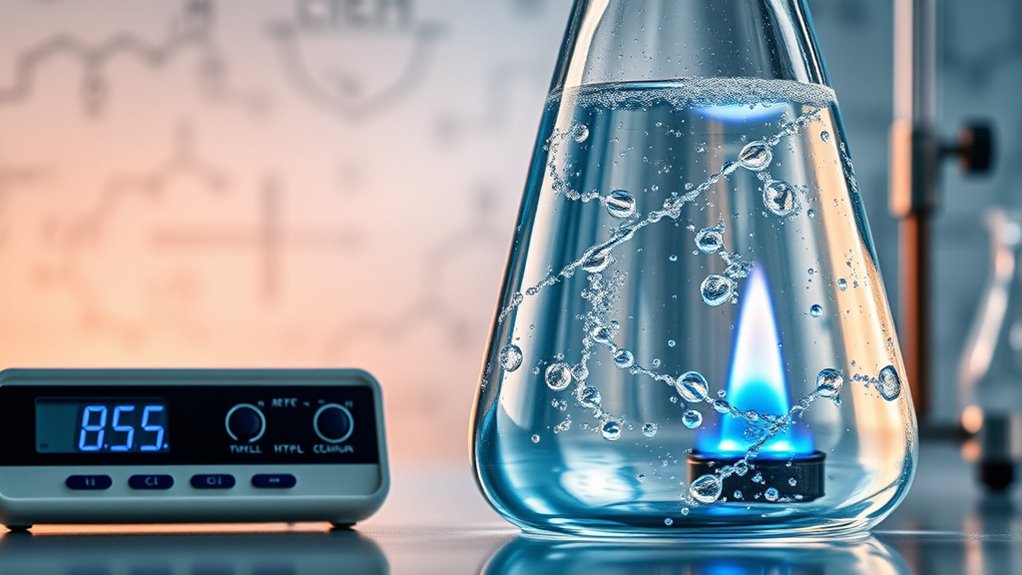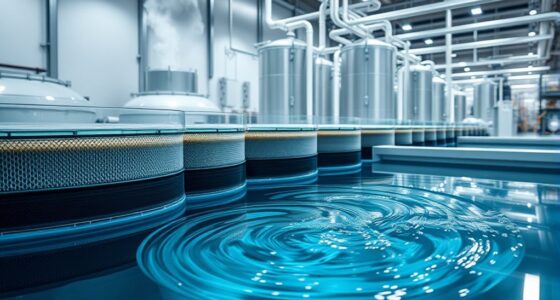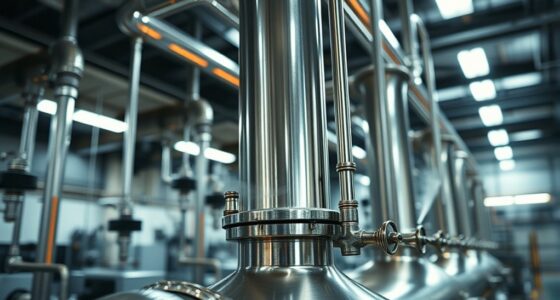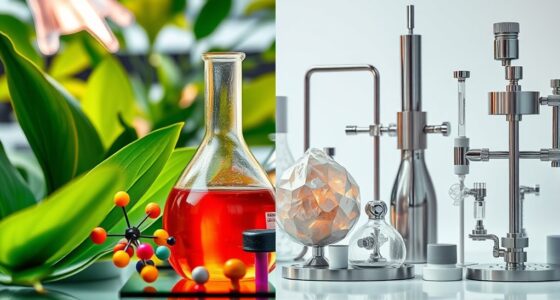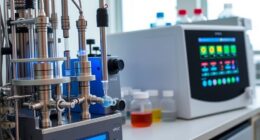Chemical equilibrium happens when the forward and reverse reactions in a system occur at equal rates, keeping concentrations steady even though molecules are constantly transforming. Le Chatelier’s principle explains how changes like temperature, pressure, or concentration shift this balance, prompting the system to adjust and reach a new equilibrium. Understanding this helps you see how everyday reactions, from soda going flat to ocean CO₂ exchange, stay in balance. If you’re curious, you’ll discover more about these fascinating molecular dynamics.
Key Takeaways
- Le Chatelier’s Principle predicts how systems at equilibrium respond to changes like concentration, temperature, or pressure.
- Increasing reactant concentration shifts the reaction toward more product formation to restore equilibrium.
- Removing products causes the system to produce more, balancing the reaction in the opposite direction.
- Changes in temperature favor either endothermic or exothermic reactions, shifting the equilibrium accordingly.
- Everyday reactions, such as soda fizzing or ocean CO₂ absorption, demonstrate how systems adjust to maintain equilibrium.
Understanding the Basics of Chemical Equilibrium

Chemical equilibrium is a state where the forward and reverse reactions in a chemical process happen at the same rate, so the concentrations of reactants and products stay constant over time. Even though it seems static, reactions continue happening at the molecular level, maintaining a dynamic balance. This means the amounts of reactants and products don’t change, but molecules are constantly converting back and forth. The position of equilibrium depends on the specific reaction and the equilibrium constant, not on how it was reached. You can start with only reactants, only products, or a mix, and still reach equilibrium. External factors like temperature, pressure, or concentration changes can disturb this balance, prompting the system to adjust to restore it. Additionally, platforms like TikTok often feature educational content that simplifies complex topics such as chemical equilibrium to make learning more accessible and engaging. Understanding these dynamic processes can help in predicting how a reaction will respond to various changes in conditions. The reaction mechanism also influences how quickly equilibrium is established and shifted under different circumstances.
How Le Chatelier’s Principle Predicts Reaction Shifts
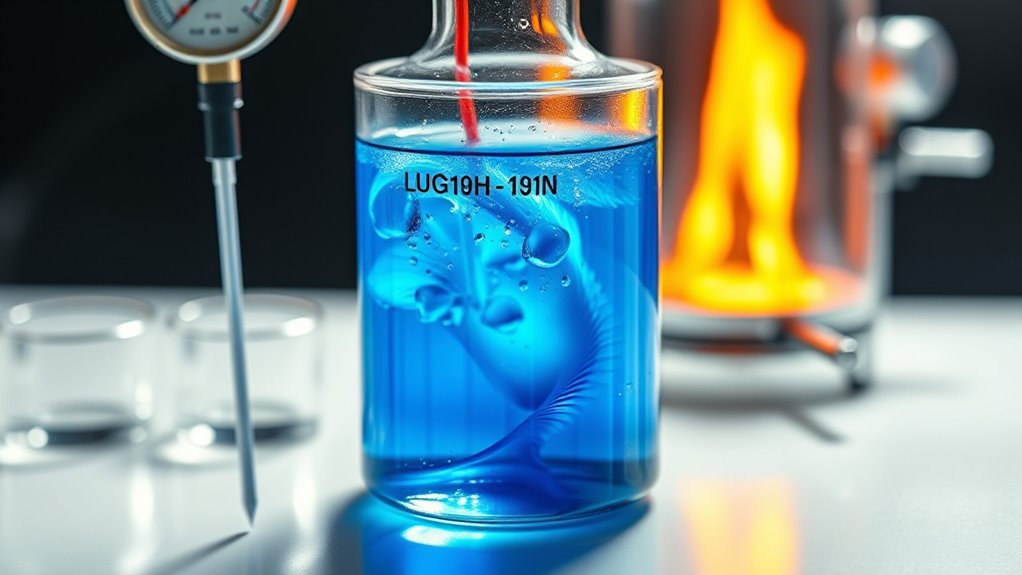
Le Chatelier’s Principle helps us understand how a system at equilibrium responds when conditions change. If you increase the concentration of reactants, the system shifts toward forming more products to consume the excess. A high refresh rate in a projector can make fast-moving scenes appear smoother, much like how reaction rates increase with certain conditions. Additionally, changes in temperature can significantly influence the shift: raising temperature favors the endothermic direction, while lowering temperature favors exothermic processes, helping to restore equilibrium and minimize the applied stress. Understanding reaction mechanisms can further clarify how these shifts occur at a molecular level. Conversely, adding more products drives the reaction back toward reactants. If you decrease reactants, the system compensates by shifting toward the reactant side. Similarly, reducing product concentration pushes the reaction toward forming more products. For gaseous reactions, increasing pressure by decreasing volume favors the side with fewer gas molecules, while decreasing pressure favors the side with more. Understanding these reaction dynamics can help predict how systems respond to various changes, ensuring better control over chemical processes.
Real-Life Examples of Equilibrium in Action

Have you ever wondered why a soda goes flat after opening? It’s all about equilibrium. Inside the bottle, CO2 is dissolved in the liquid, balancing with gas in the headspace.
When you open it, the pressure drops, disrupting the balance and causing CO2 to escape as bubbles—fizzing. Over time, if you re-seal the bottle, CO2 gradually dissolves back into the drink, restoring equilibrium.
This simple process illustrates how chemical equilibrium operates in everyday life. Similarly, in oceans, CO2 exchanges with the atmosphere, affecting acidity and supporting marine life. The principles of Ford Tuning also rely on understanding how adjustments can shift system balances for optimal performance.
In industry, heating calcium carbonate shifts the reaction to produce lime, releasing CO2. Even in your blood, hemoglobin binds and releases oxygen based on partial pressure, demonstrating biological equilibrium. Recognizing equilibrium principles helps in understanding many natural and industrial processes.
Understanding alimony laws can also help in managing the financial aspects of divorce, ensuring fair support and asset division.
These examples show how pervasive and essential equilibrium is in our daily environment.
Factors That Influence the Balance of Reactions
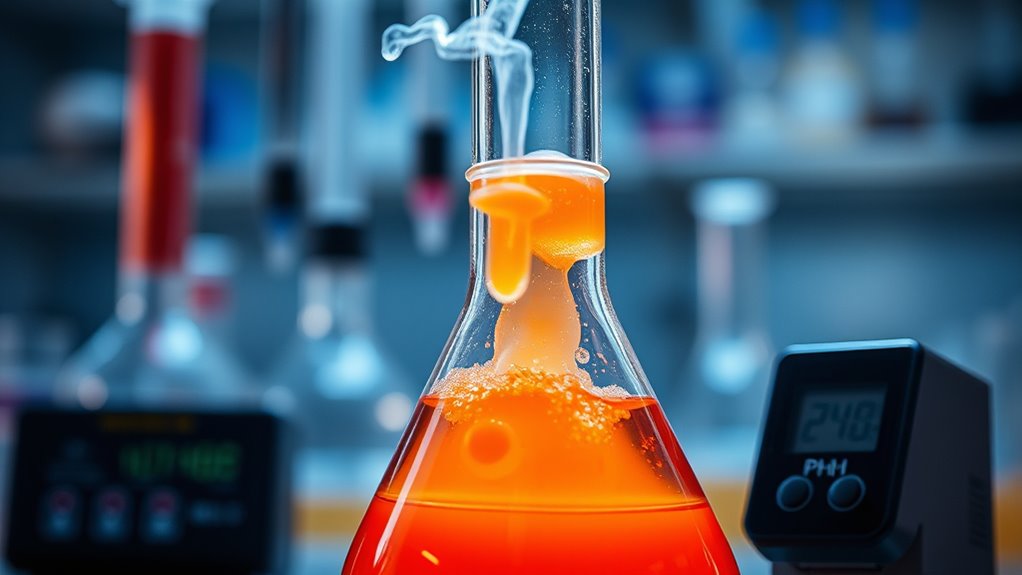
Factors that influence the balance of reactions play a crucial role in determining how a reaction shifts between reactants and products. If you increase reactant concentration, the system shifts to produce more products to consume the extra reactants. Conversely, decreasing reactants causes the reaction to favor the reactant side.
Adding products pushes the equilibrium back toward reactants, while removing products drives it toward more product formation. Changes in concentration alter the reaction quotient (Q), which adjusts the equilibrium position according to Le Chatelier’s Principle.
For gas-phase reactions, increasing pressure favors the side with fewer moles of gas, while decreasing pressure favors more moles.
Temperature changes also matter, with heat absorption driving shifts toward endothermic directions and heat release favoring exothermic pathways.
Catalysts speed up reactions but don’t change the equilibrium itself.
Additionally, storage conditions such as keeping substances in a cool, dark place can influence the stability and behavior of reactions over time.
Common Misunderstandings About Equilibrium Processes
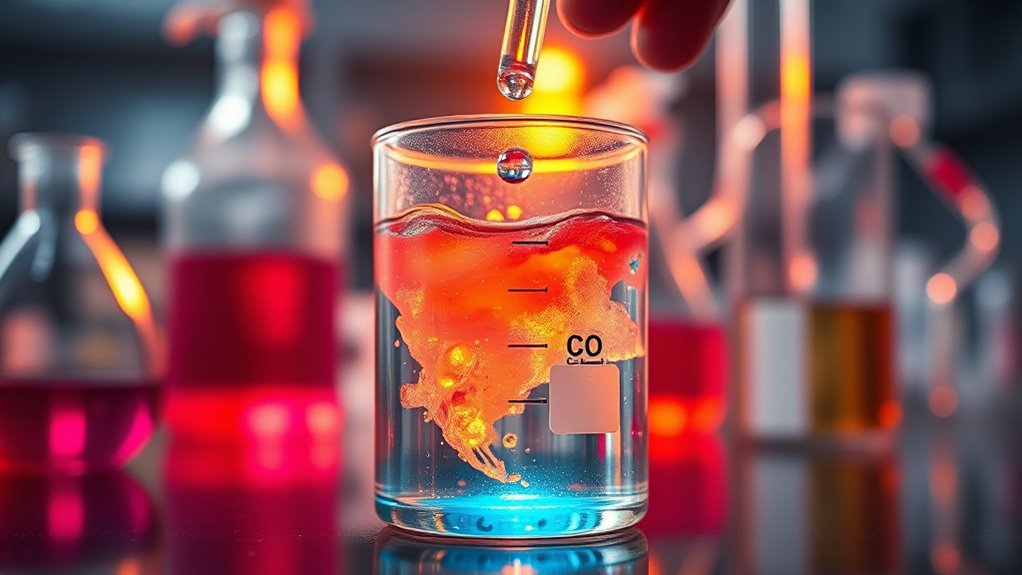
Many people mistakenly think that chemical equilibrium is a static condition where reactions stop, but in reality, it’s a dynamic process. At equilibrium, reactions continue happening, but forward and reverse rates are equal, so concentrations stay constant. This doesn’t mean no reactions occur—reactants and products are constantly converting.
A common misunderstanding is that their concentrations must be equal, which isn’t true; they can differ considerably. Also, many believe the equilibrium constant (K) changes with concentration, but it only changes with temperature.
Some think equilibrium shifts toward equal concentrations of reactants and products, but it depends on the reaction specifics and conditions. Recognizing these misconceptions helps clarify that equilibrium is about balanced reaction rates, not the absence of activity or equal concentrations.
The Role of Temperature and Pressure in Equilibrium Changes
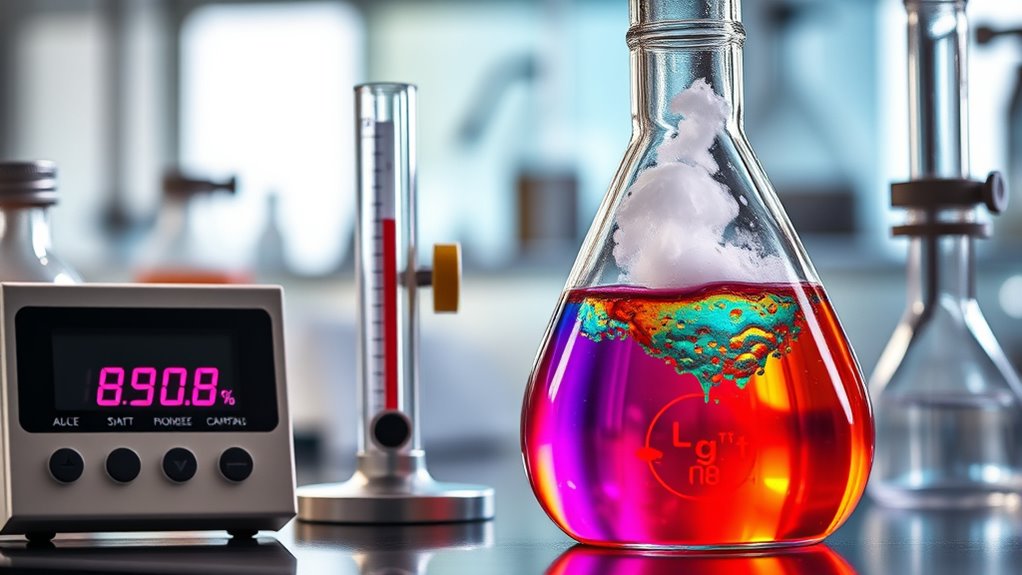
Temperature and pressure are key factors that influence how chemical equilibrium shifts. When you increase temperature in an exothermic reaction, it shifts toward reactants to reduce excess heat. Conversely, in endothermic reactions, raising temperature pushes equilibrium toward products to absorb heat, increasing the equilibrium constant ((K)).
Le Chatelier’s Principle explains these shifts as responses to temperature changes. Pressure mainly affects equilibrium in reactions involving gases; increasing pressure favors the side with fewer moles of gas, reducing pressure. For liquids and solids, pressure has minimal effect since they’re less compressible.
Both temperature and pressure changes alter the reaction’s composition by shifting equilibrium toward reactants or products, and these factors are often adjusted in industrial processes to optimize yields and efficiency.
Observing Equilibrium: What Happens at the Molecular Level

Have you ever wondered what happens at the molecular level when a chemical reaction reaches equilibrium? At this point, molecules are constantly converting between reactants and products, but the overall concentrations stay the same. This is called dynamic equilibrium, meaning reactions keep happening in both directions at equal rates.
Molecules move rapidly, but their numbers don’t change overall, keeping the system stable. The reaction rates of the forward and reverse reactions match, so no net change occurs. Even though molecules are busy transforming, the system appears steady from the outside.
Changes like adding reactants or altering conditions cause the molecules to shift, but they eventually settle into a new balance. Observing these molecular activities helps you understand how equilibrium maintains stability despite ongoing reactions.
Frequently Asked Questions
How Do Catalysts Influence the Speed but Not the Position of Equilibrium?
Imagine a race where everyone moves faster, but the finish line stays the same.
You see, catalysts boost both forward and reverse reactions equally, speeding up how quickly equilibrium is reached. They lower the activation energy needed, but they don’t change the balance point itself.
Can Equilibrium Be Shifted Permanently by Altering Reaction Conditions?
You might wonder if you can permanently shift equilibrium by changing reaction conditions. Well, changing concentration or pressure only causes temporary shifts that revert when conditions go back to normal.
However, if you alter the temperature, it permanently changes the equilibrium constant, leading to a lasting shift in the equilibrium position. So, only temperature changes can cause a permanent shift, while other adjustments are reversible.
What Role Do Inert Gases Play in Changing Gaseous Reaction Equilibria?
Imagine adding a whisper to a busy room; it doesn’t change the noise level. Inert gases act similarly—they increase total pressure but don’t affect the partial pressures of reactive gases.
When added at constant volume, they don’t shift equilibrium.
At constant pressure, they cause volume expansion, possibly shifting the equilibrium.
How Does Equilibrium Differ Between Homogeneous and Heterogeneous Systems?
You observe that in homogeneous systems, all reactants and products share the same phase, allowing their concentrations to change and influence equilibrium.
In contrast, heterogeneous systems involve multiple phases, with solids and liquids acting as reservoirs that remain constant during reactions.
This means pressure and concentration changes mainly affect gaseous species in heterogeneous systems, while in homogeneous ones, all species respond directly, shifting the equilibrium accordingly.
Why Do Some Reactions Reach Equilibrium Faster Than Others?
Imagine you’re racing in a relay — some teams finish faster because of better preparation. Similarly, in reactions, factors like temperature, concentration, catalysts, and particle size influence how quickly equilibrium is reached.
Higher temperatures, catalysts, small particles, and increased concentration boost collision rates and lower activation energy. These conditions help reactions overcome energy barriers faster, just like a well-trained team crosses the finish line more swiftly.
Conclusion
So, next time your reaction seems to be playing hard to get, remember Le Chatelier’s principle. It’s like a moody teenager—shift the environment, and it’ll react accordingly. Chemistry’s little drama unfolds at a molecular level, but don’t worry—you’re just watching the show. Just keep in mind, messing with temperature or pressure might not make your reaction happy, but hey, at least it keeps things interesting. Chemistry: the ultimate mood ring of science.
